
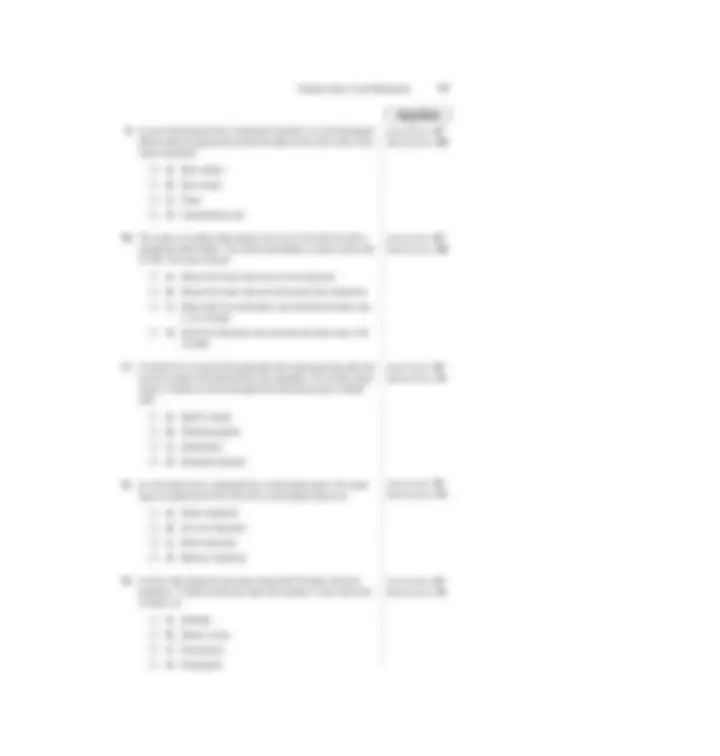
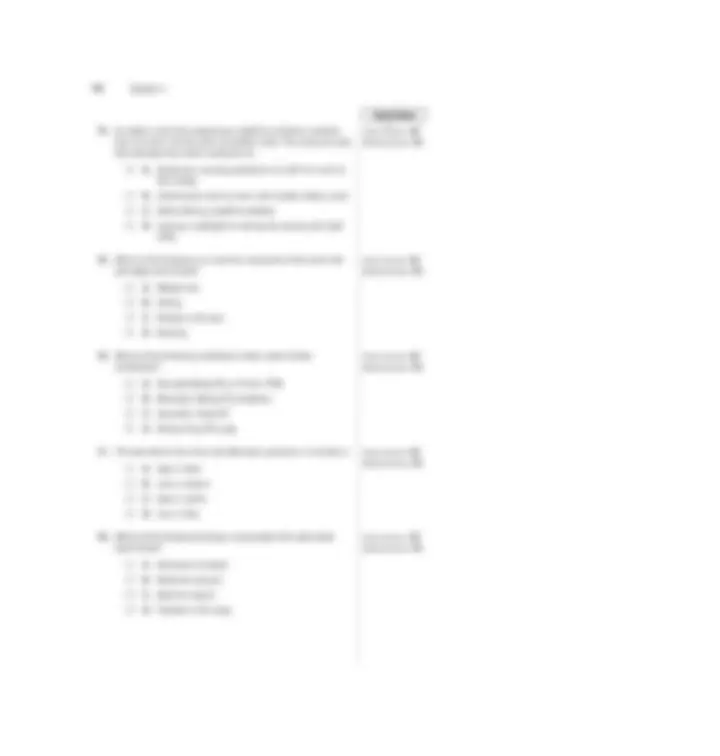
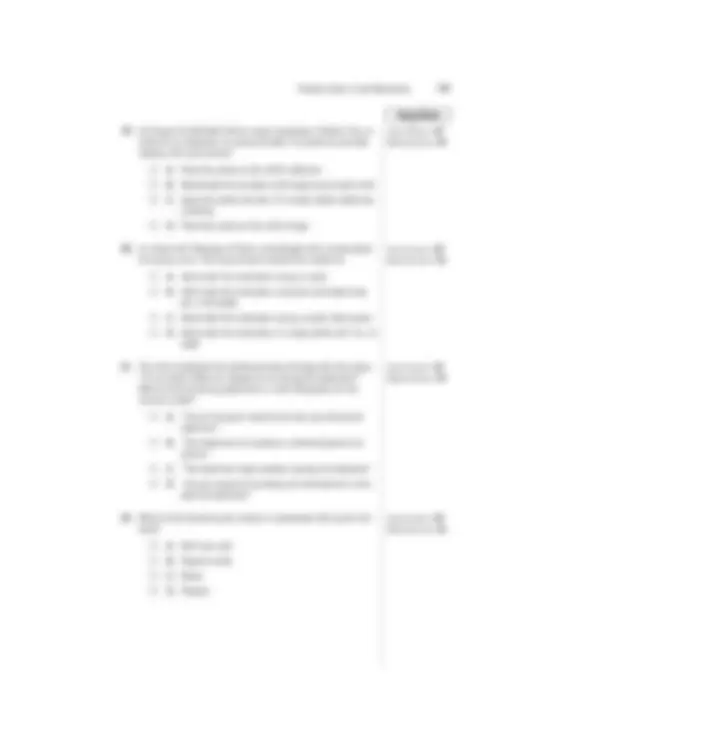
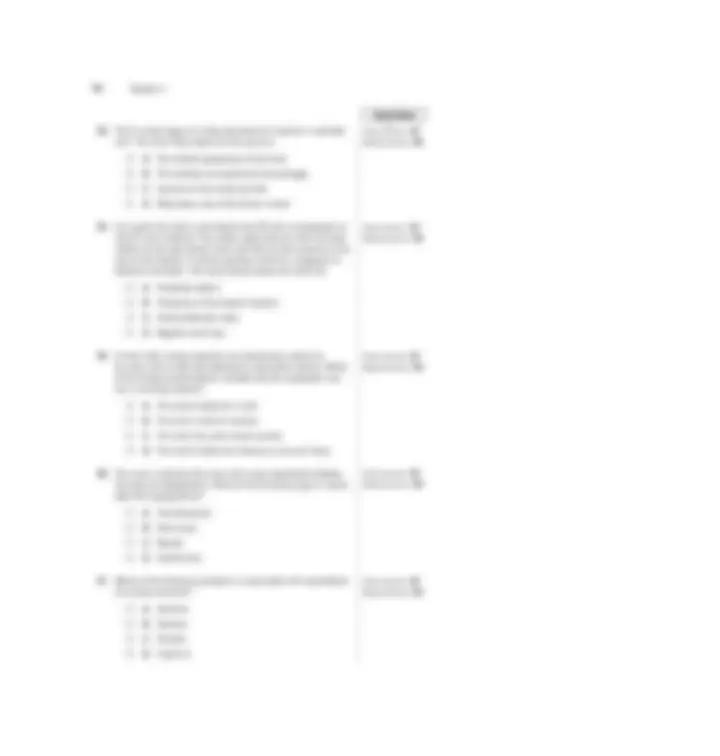
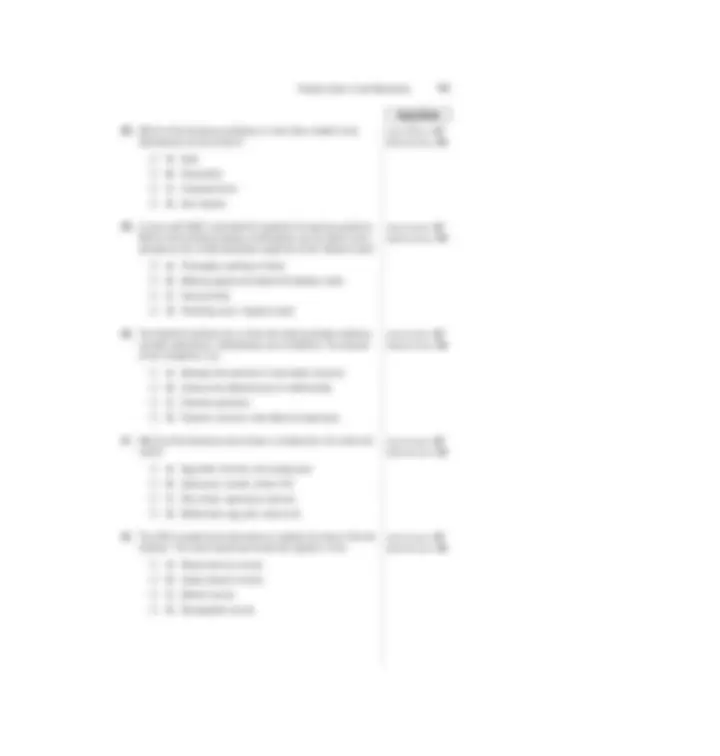
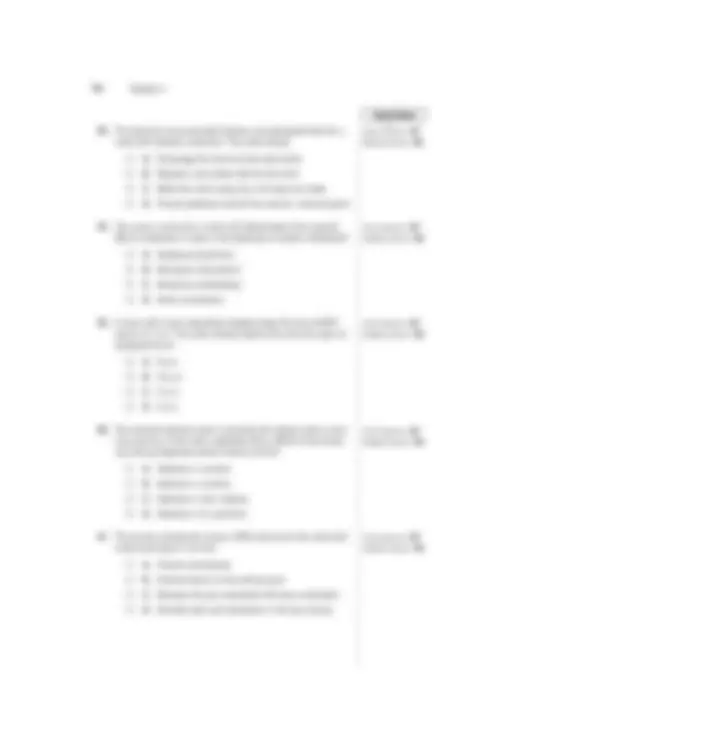
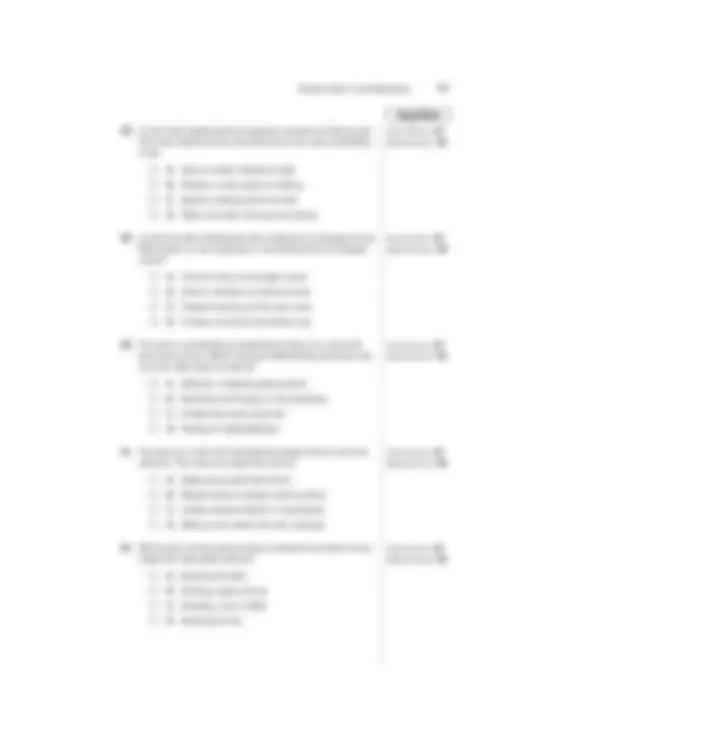
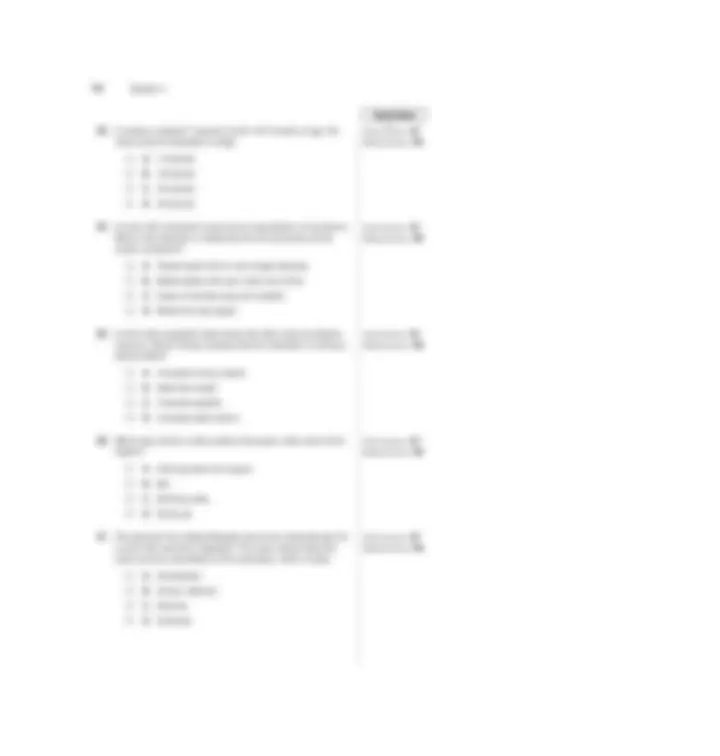
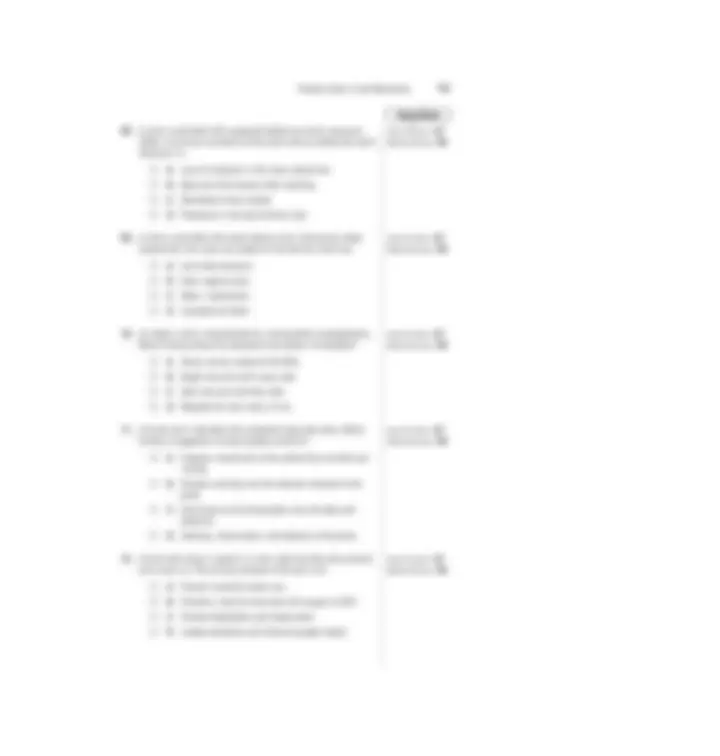
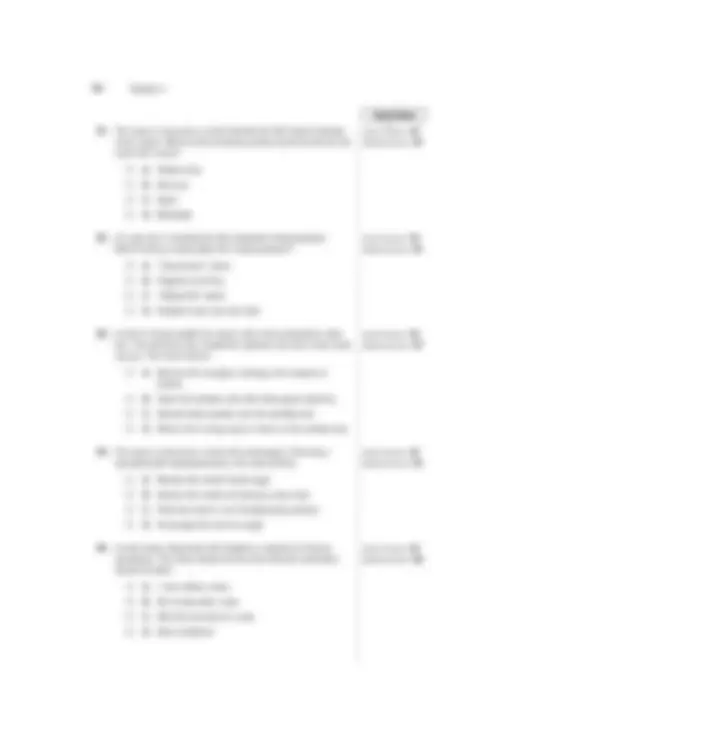
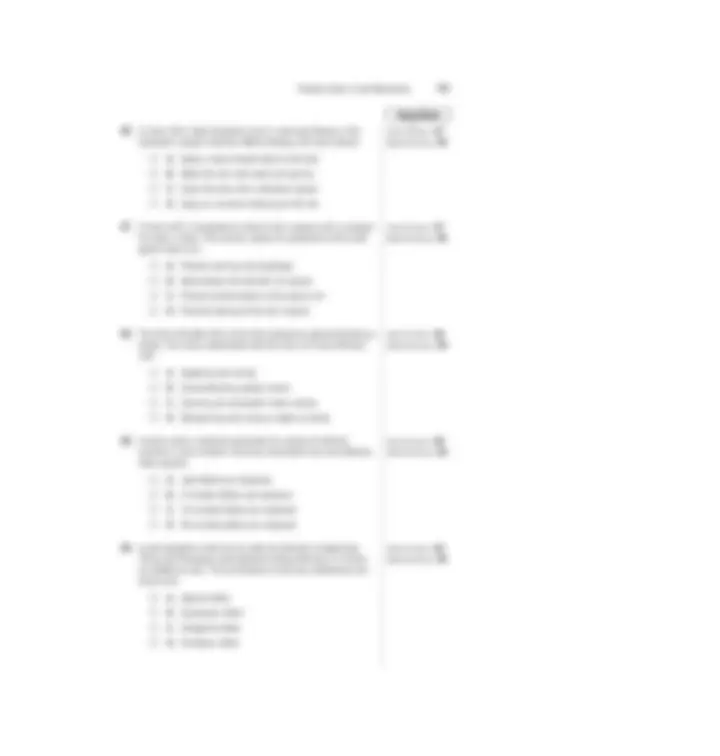
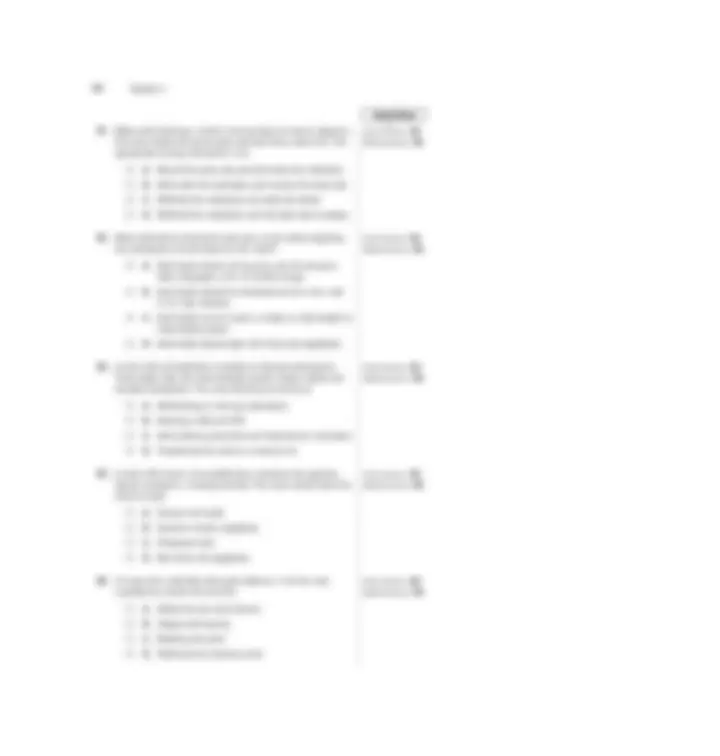
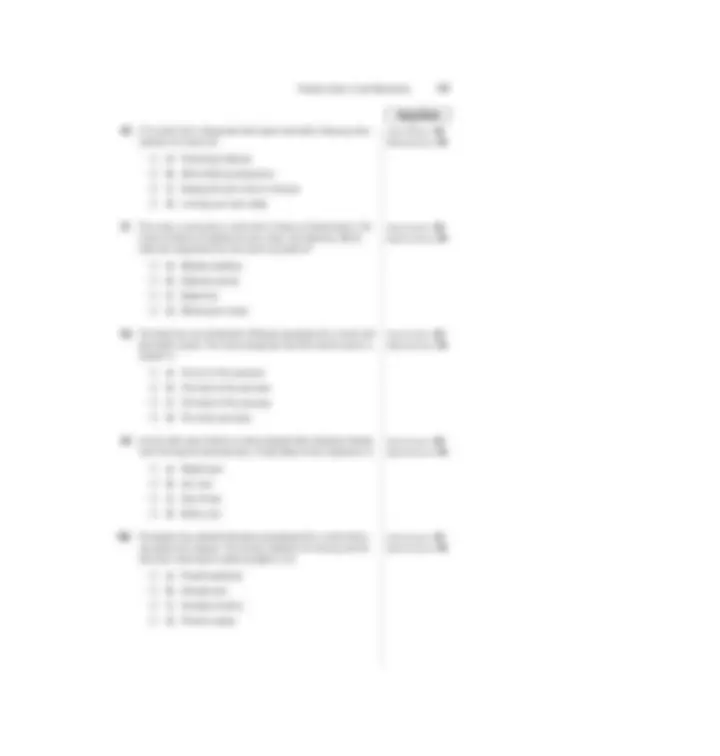
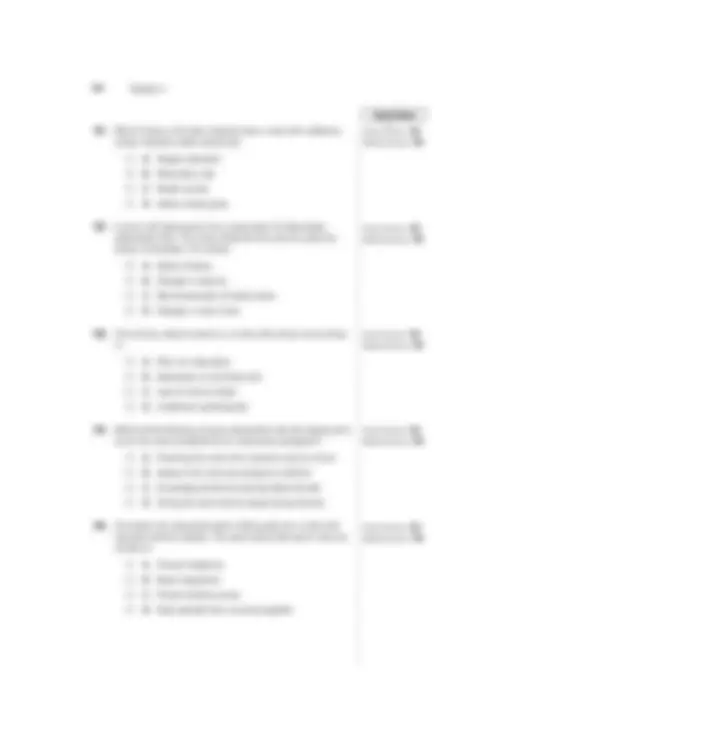
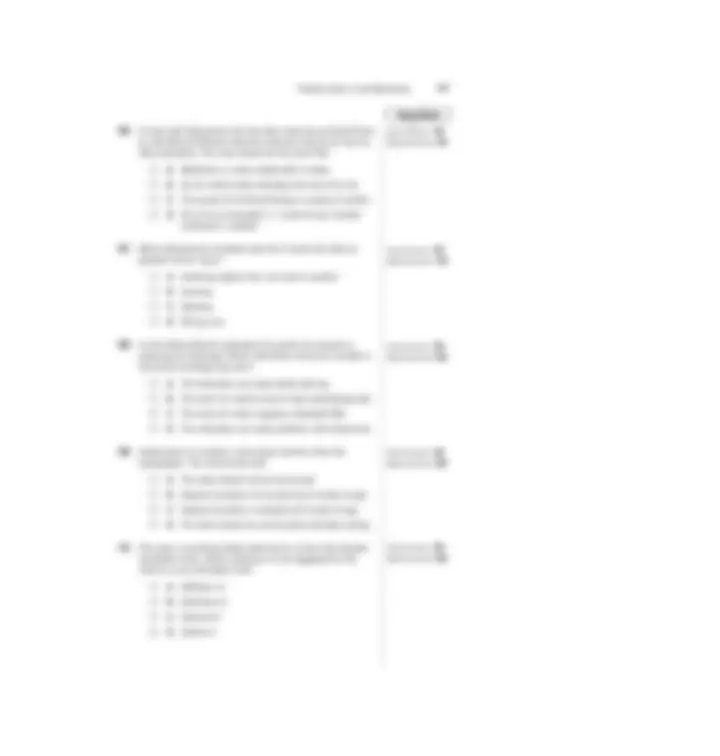
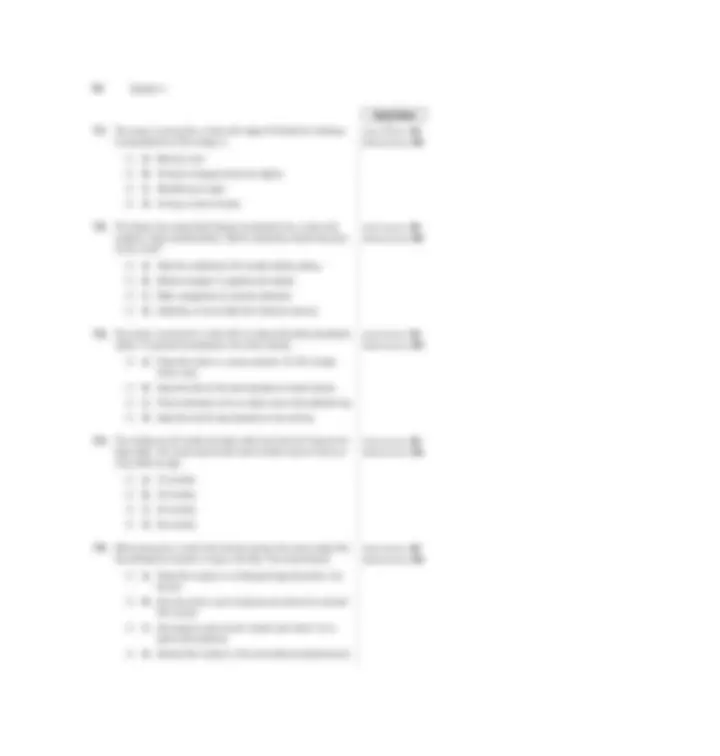
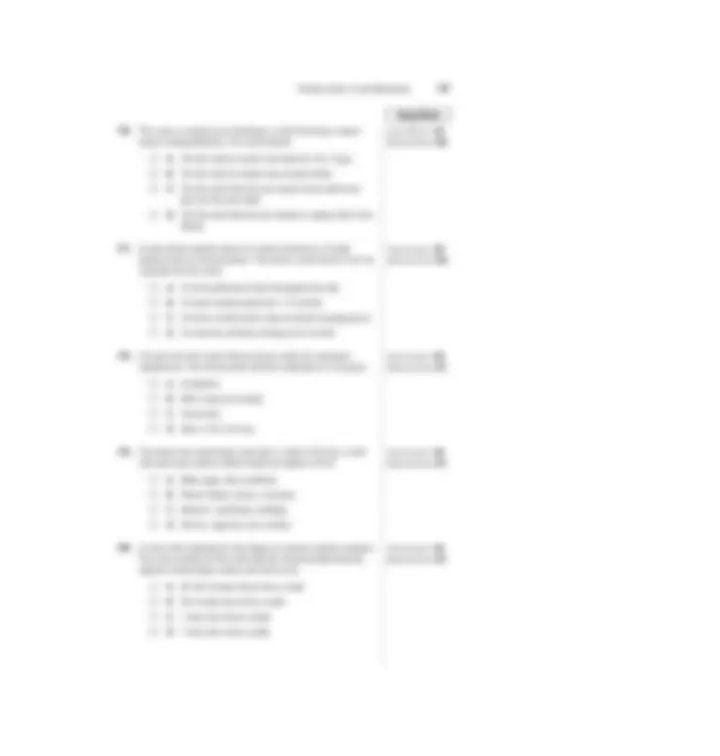
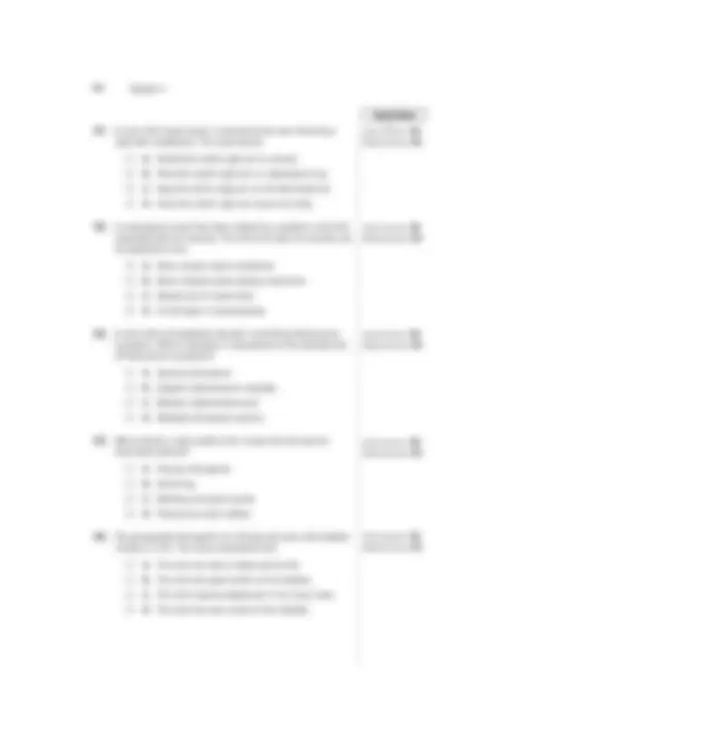
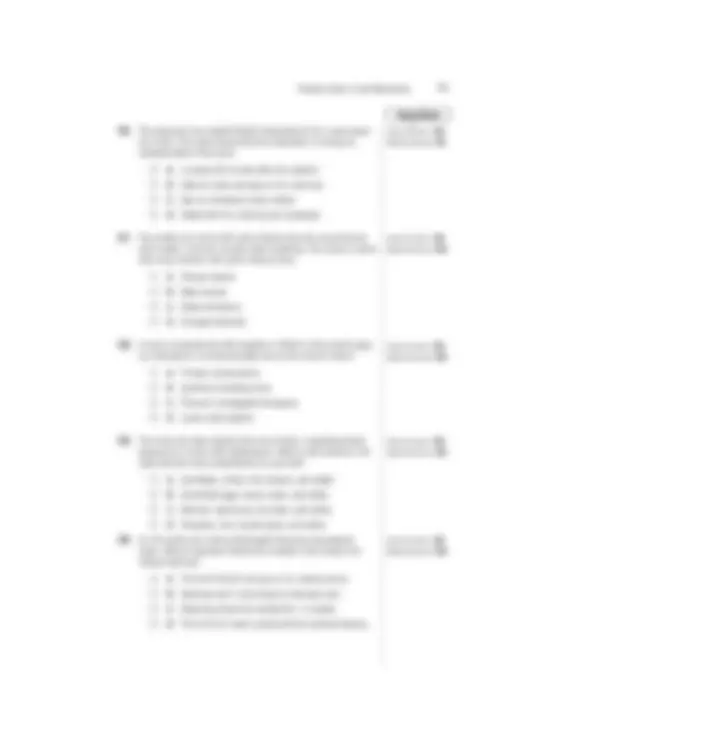
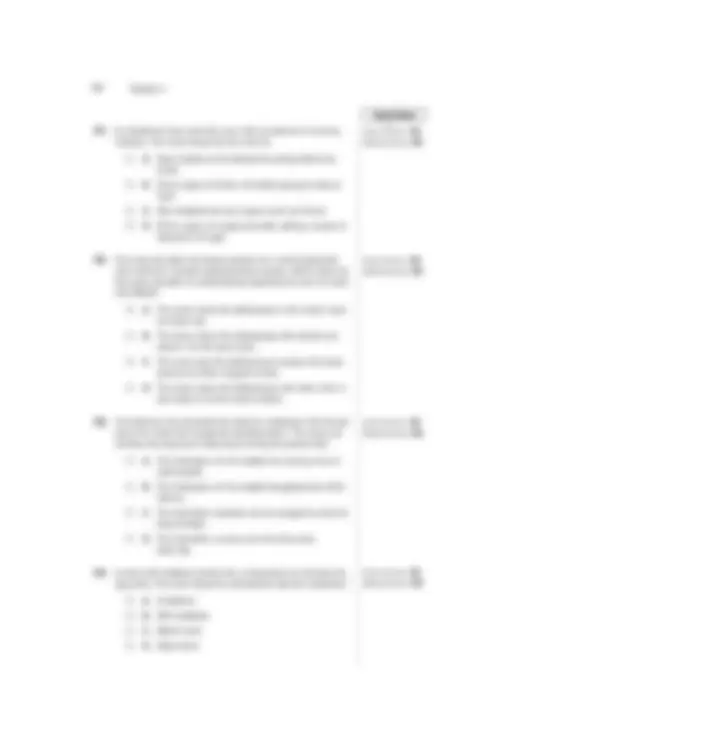
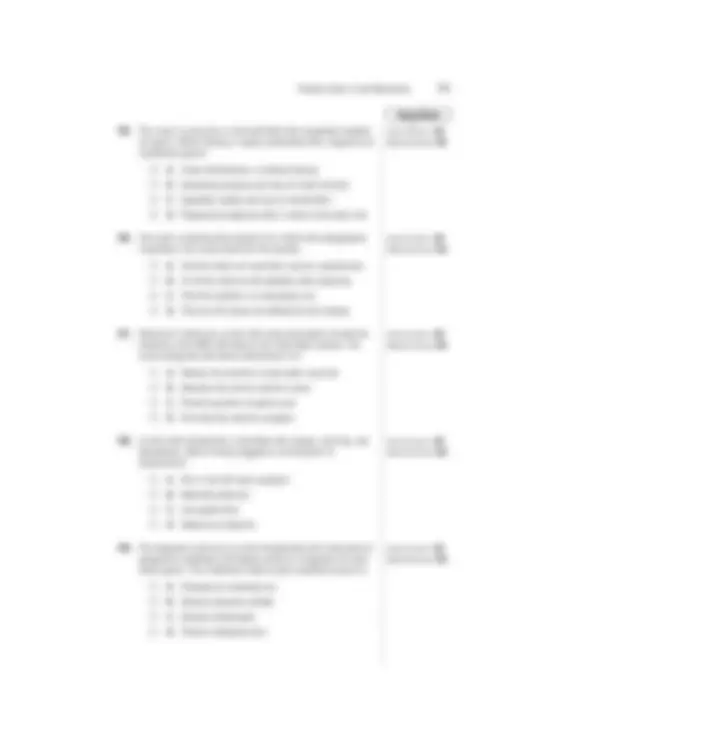
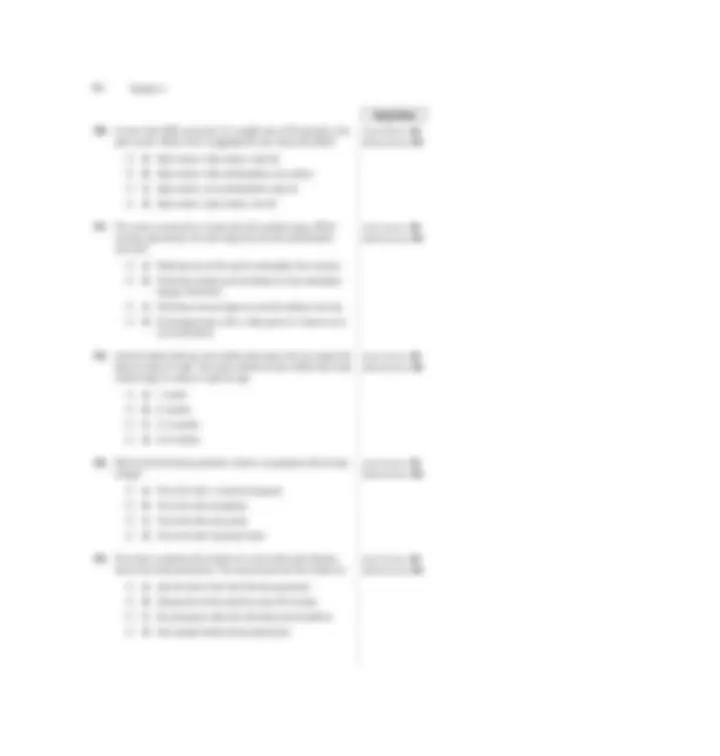
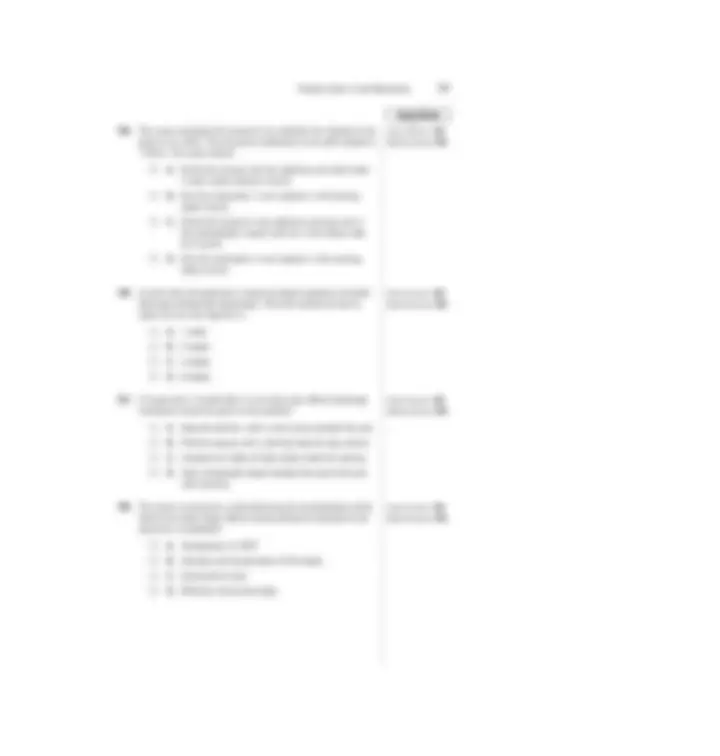
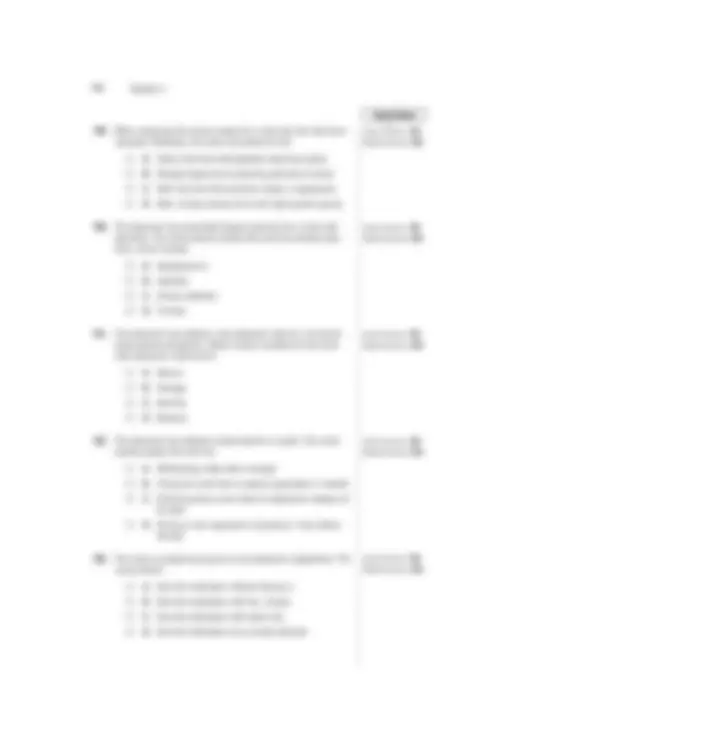
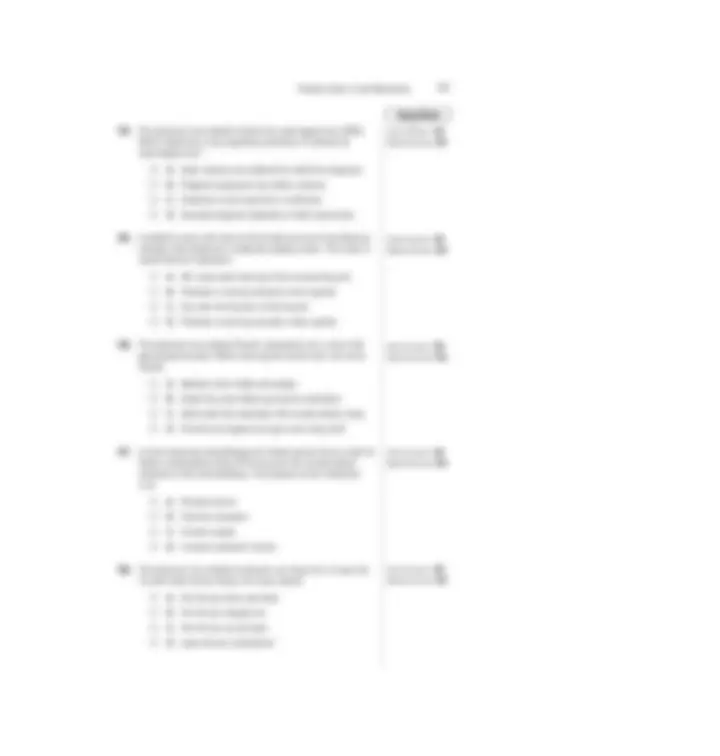
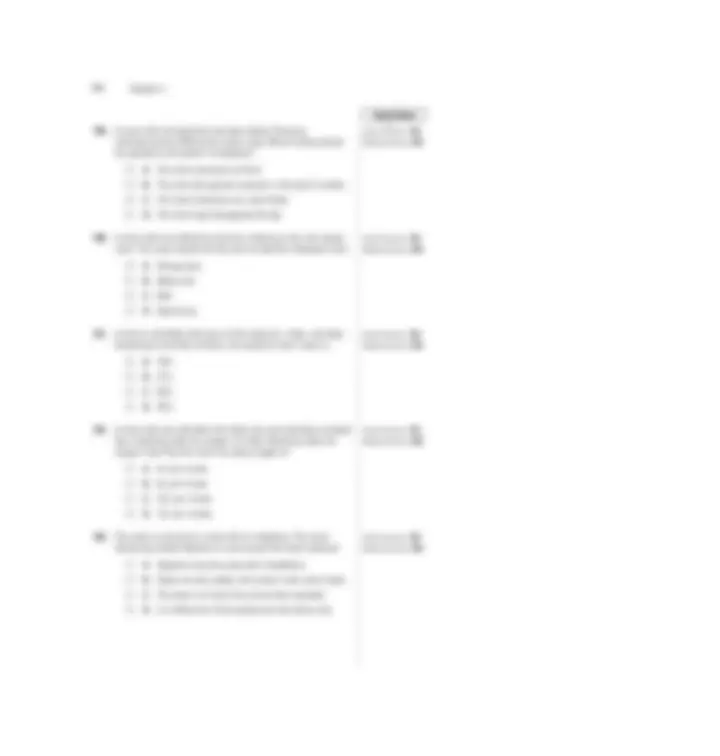
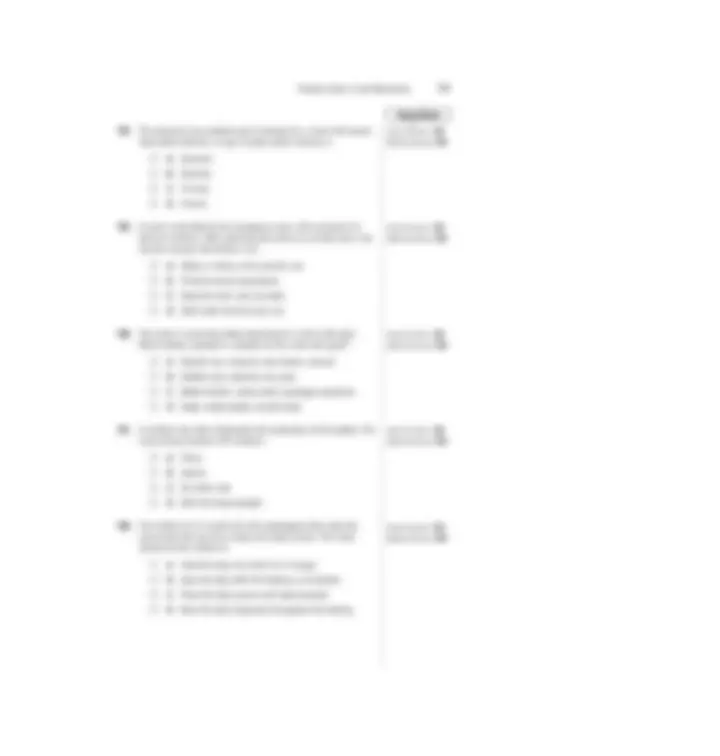
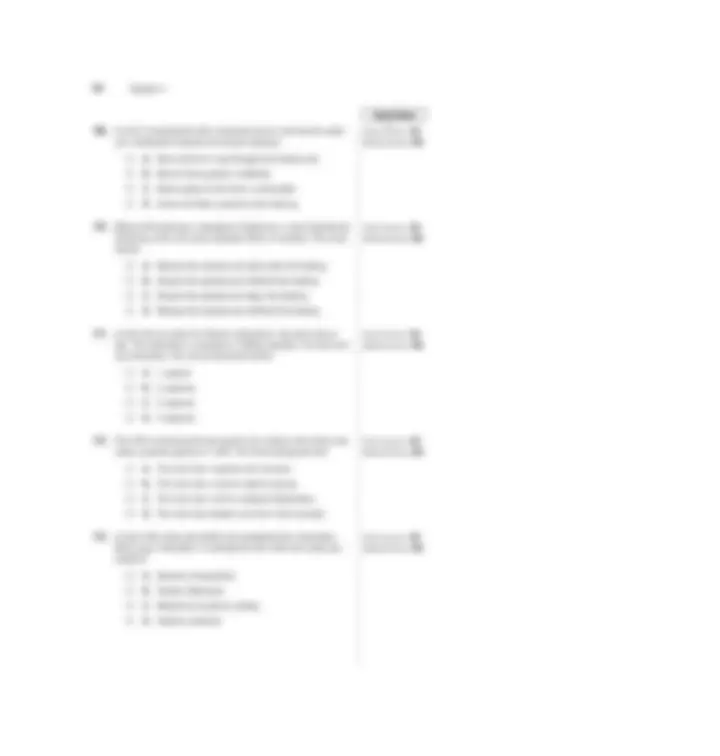
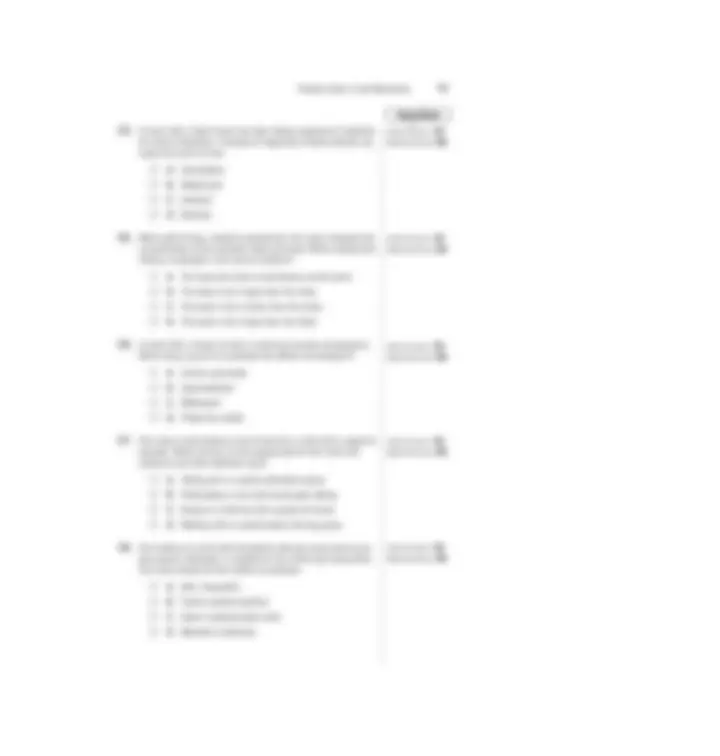
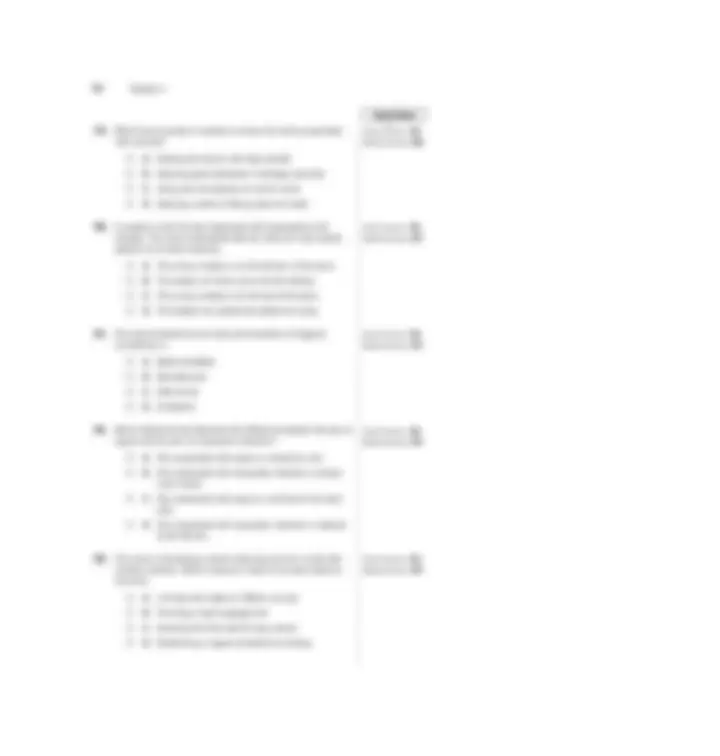
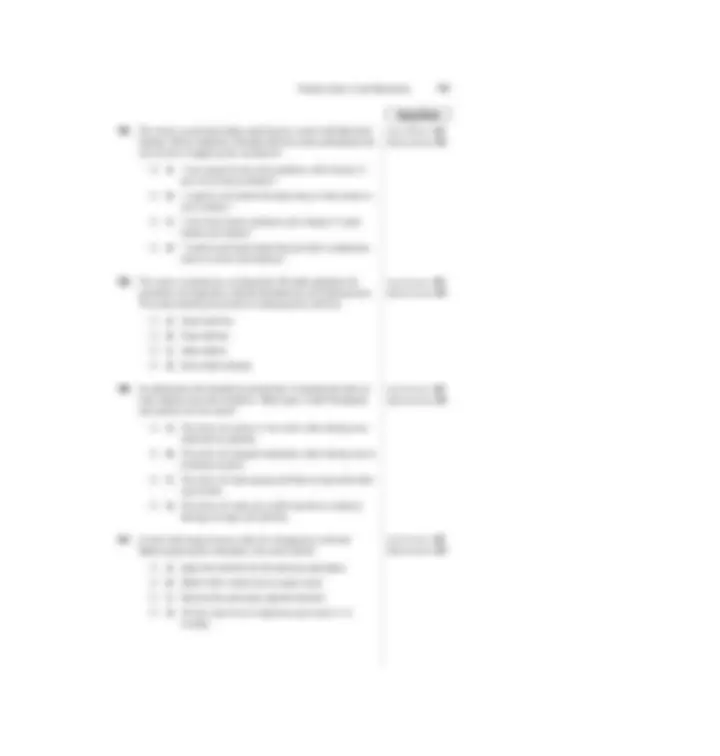
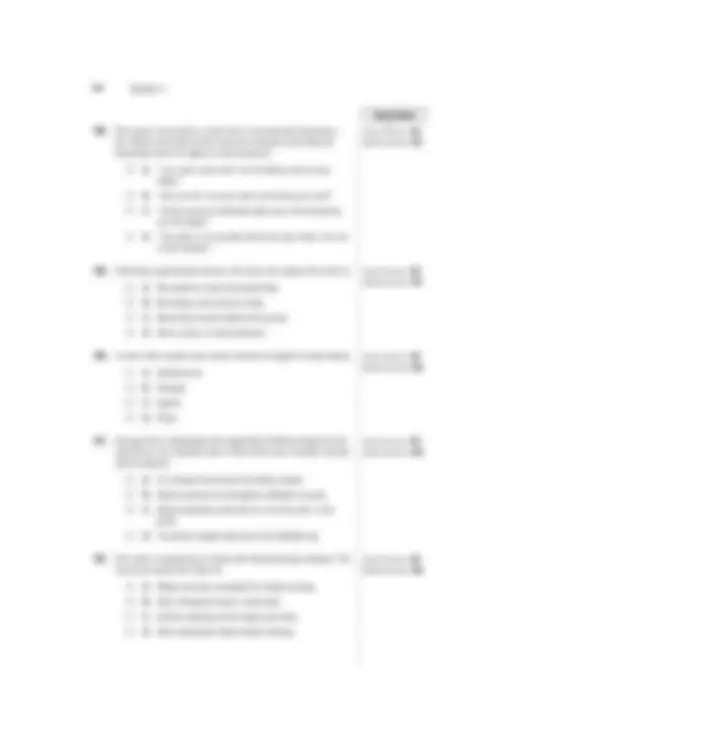
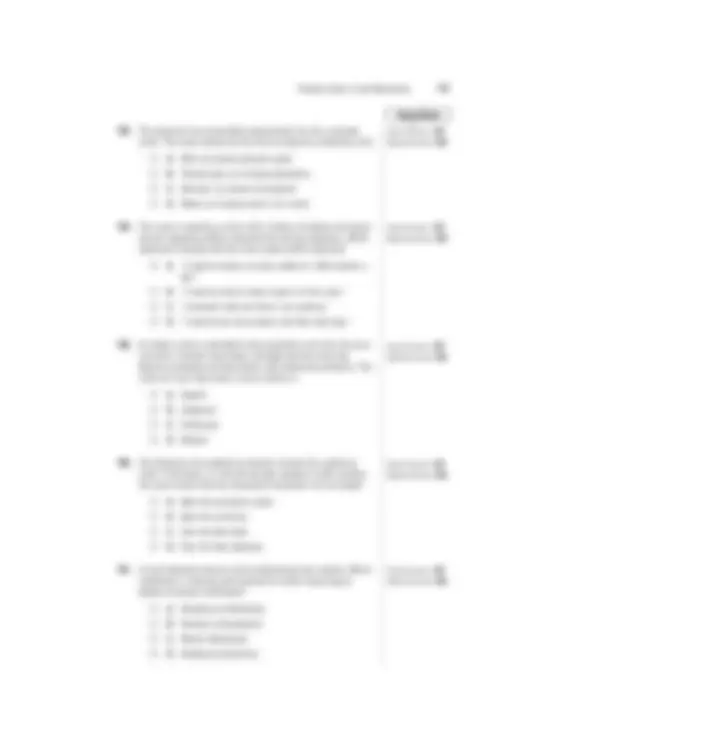
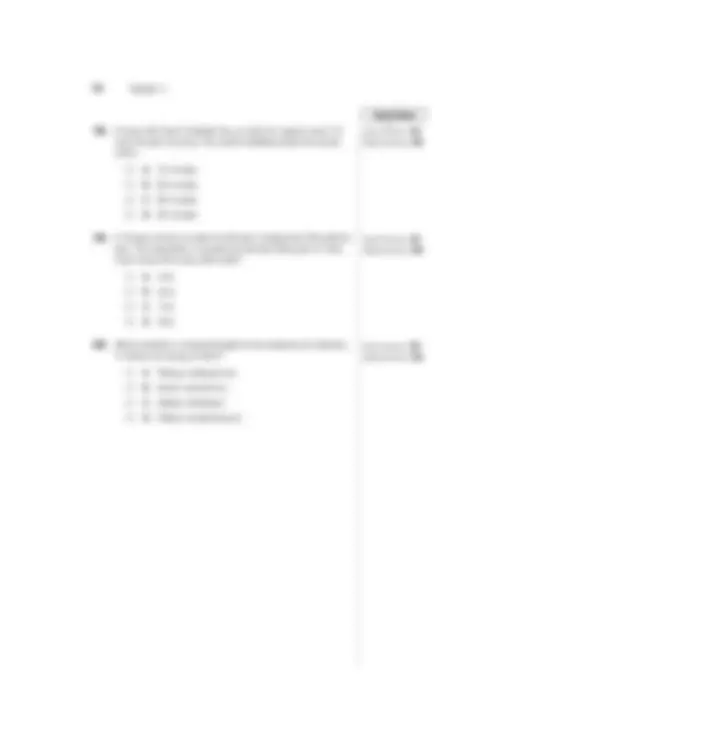
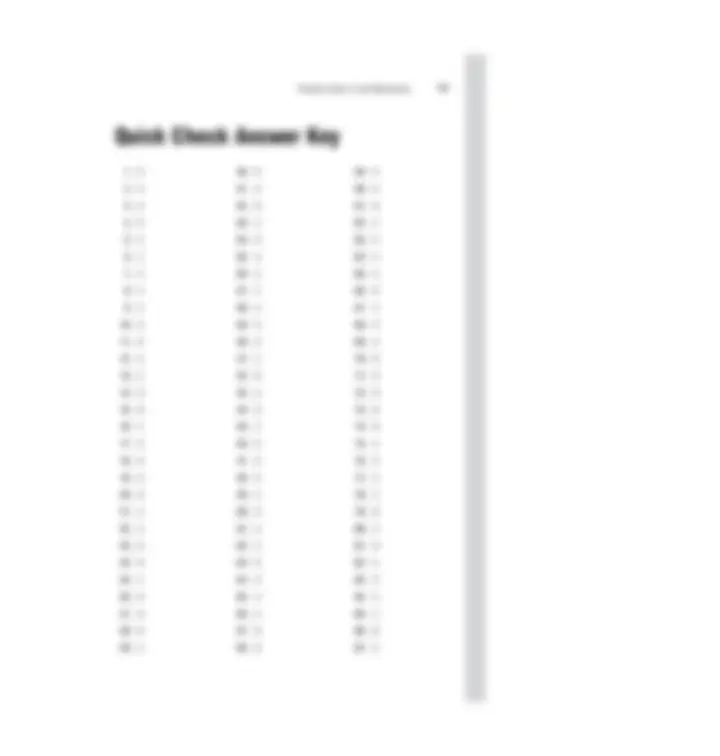
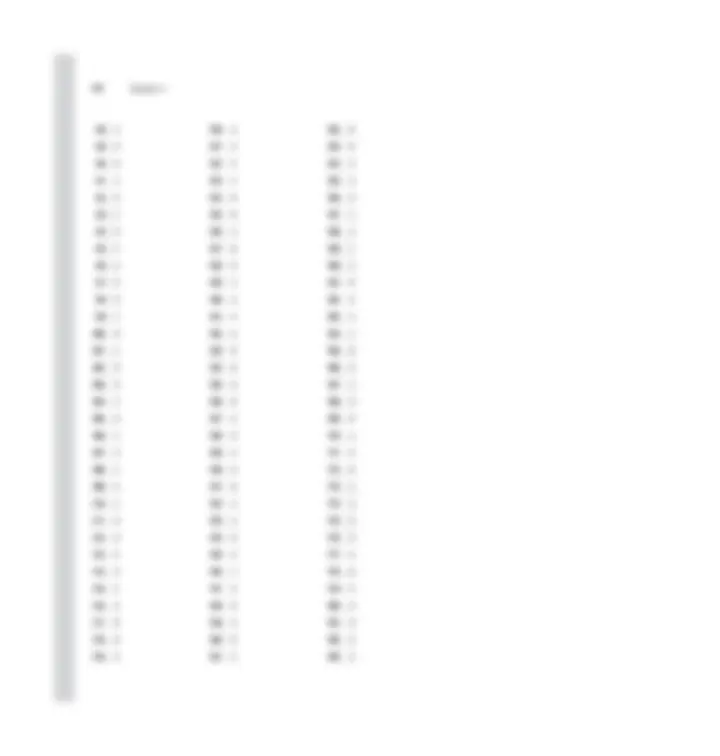
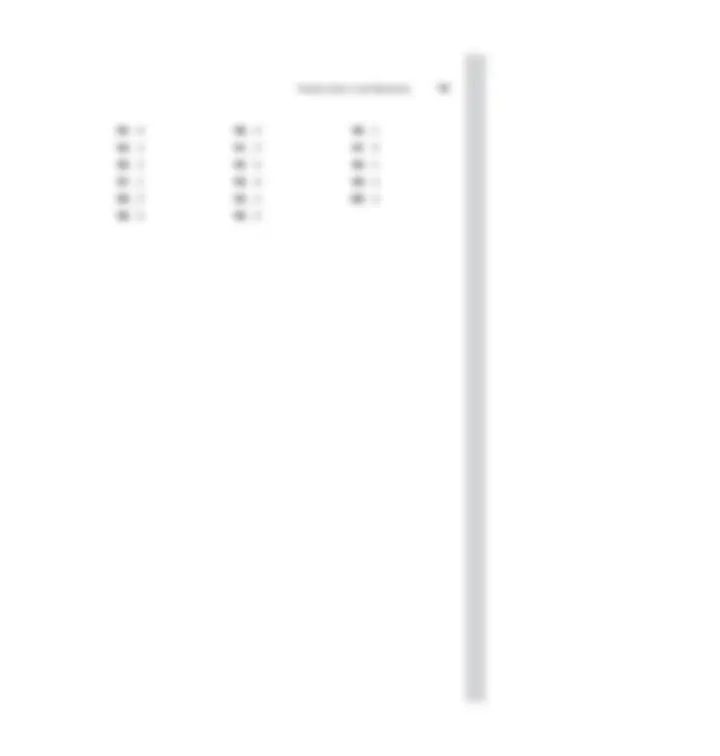
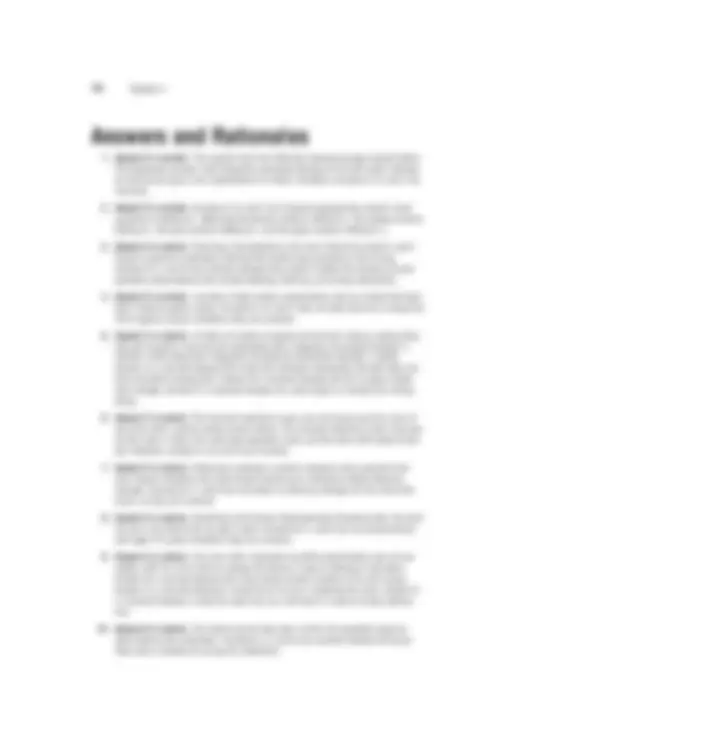
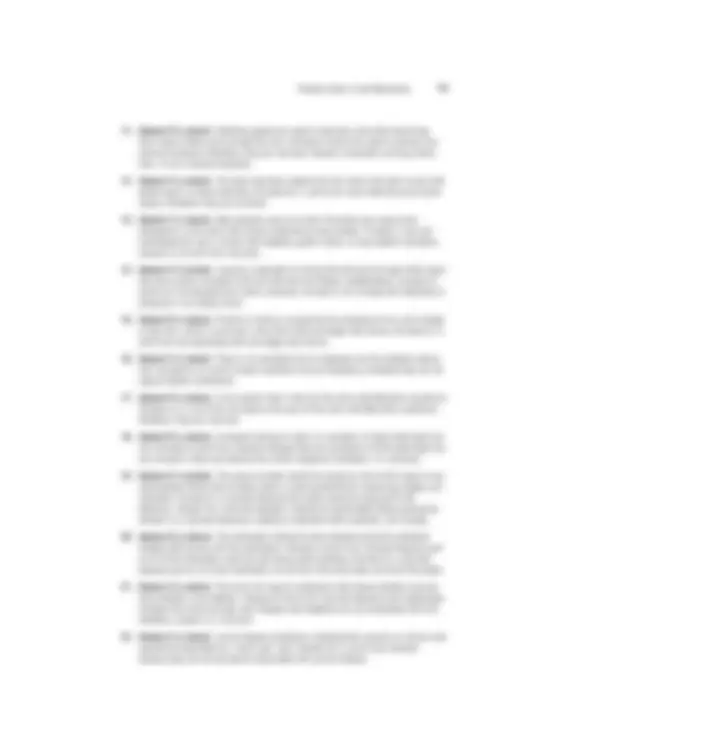
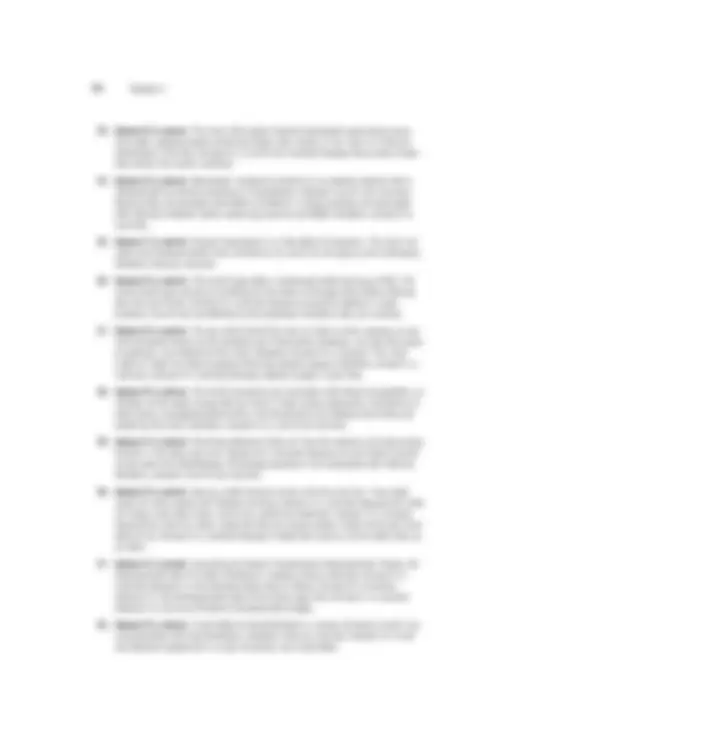

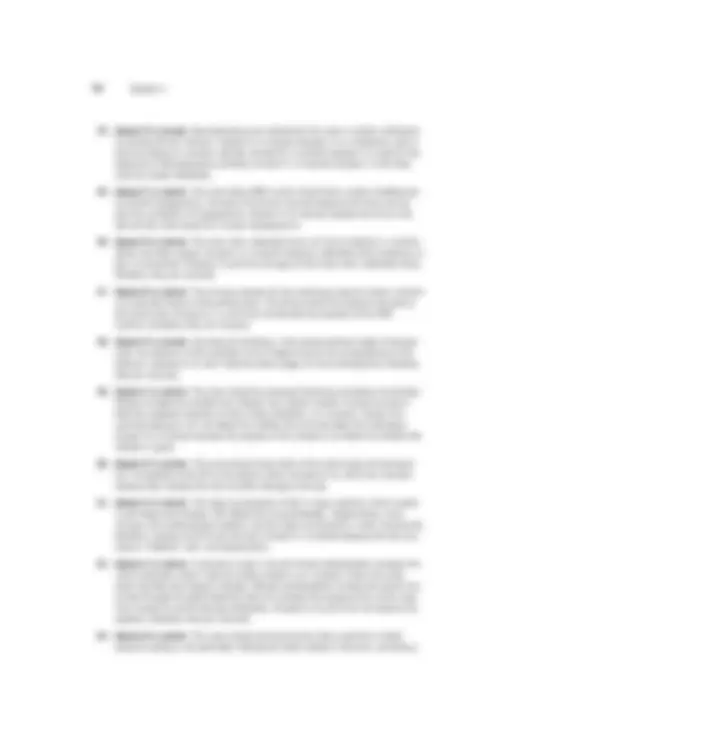
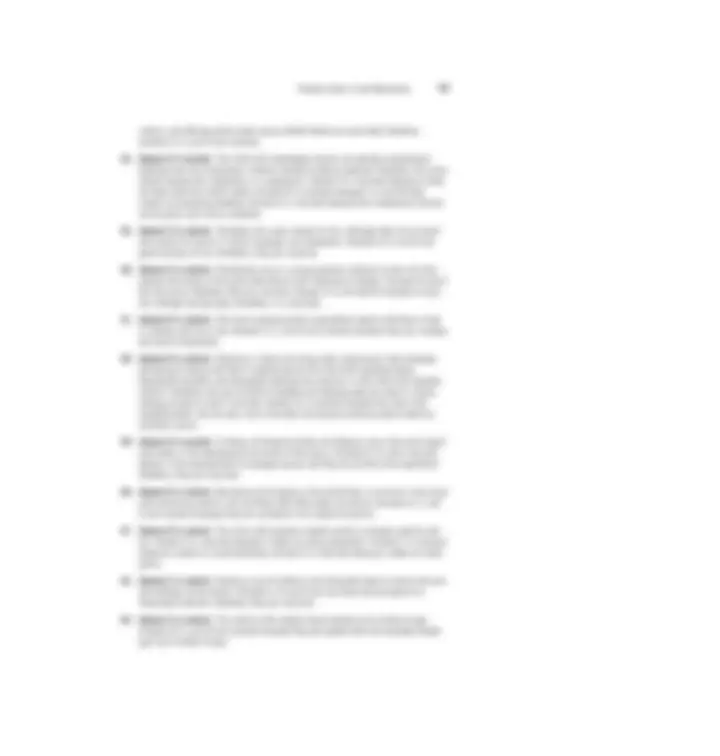
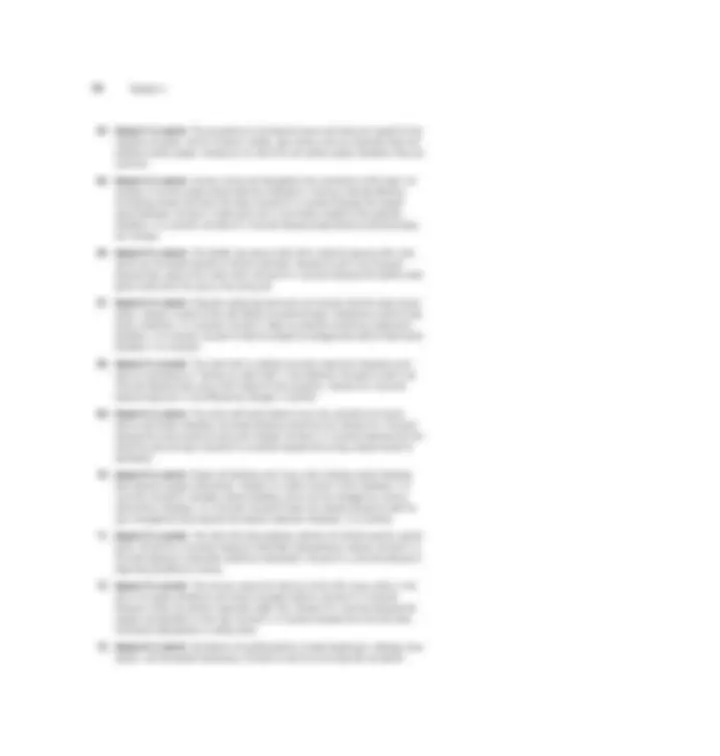
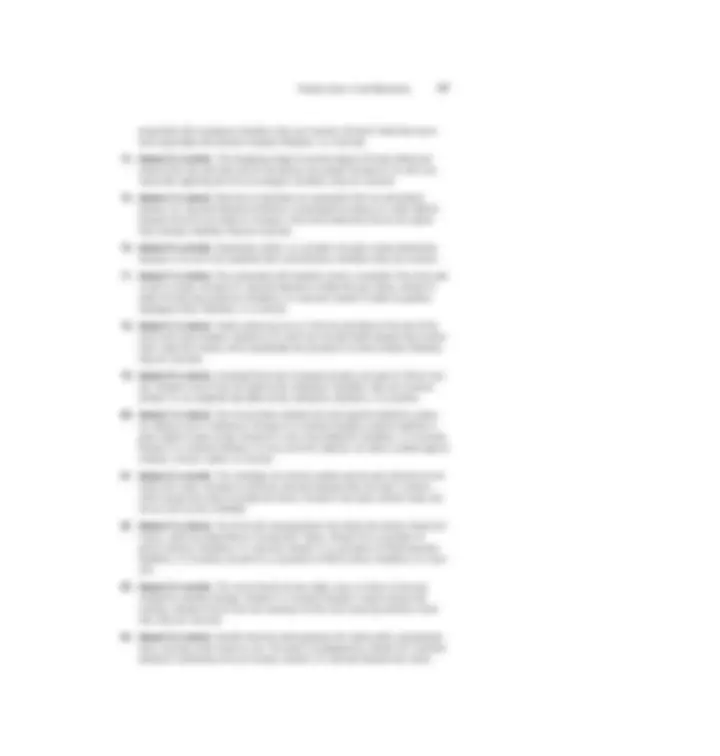
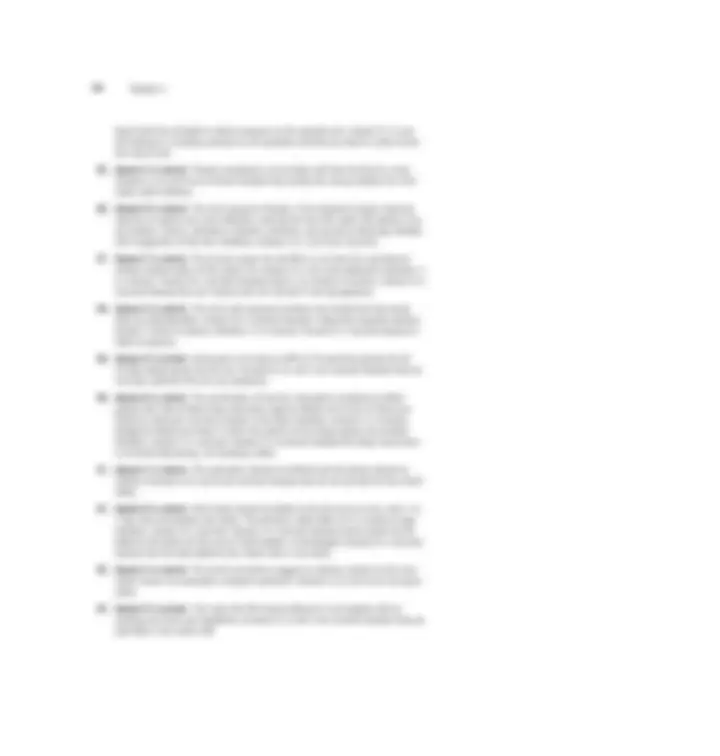
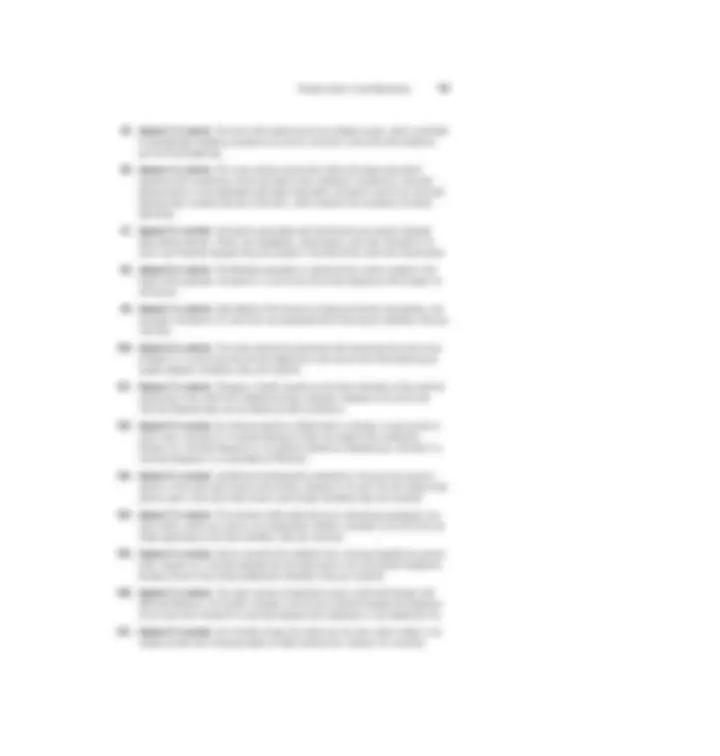
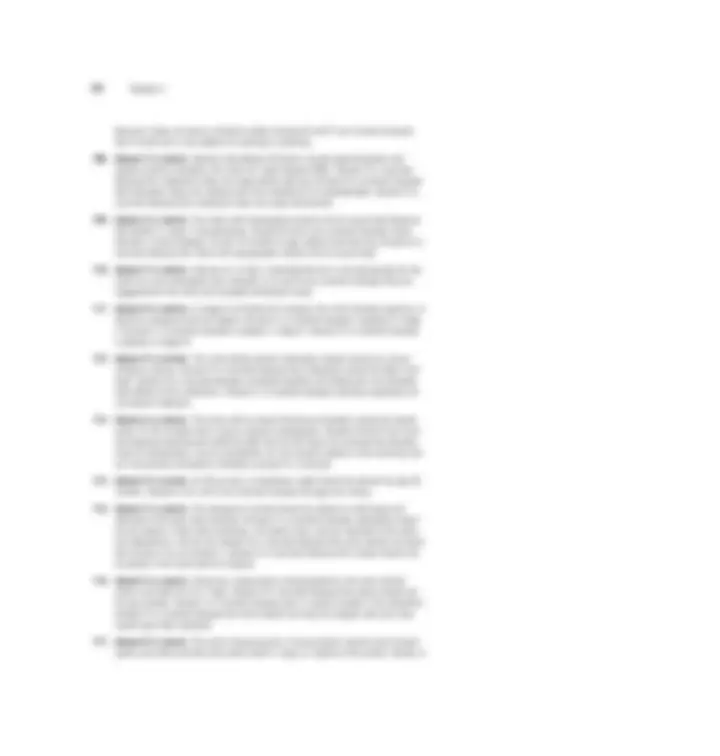
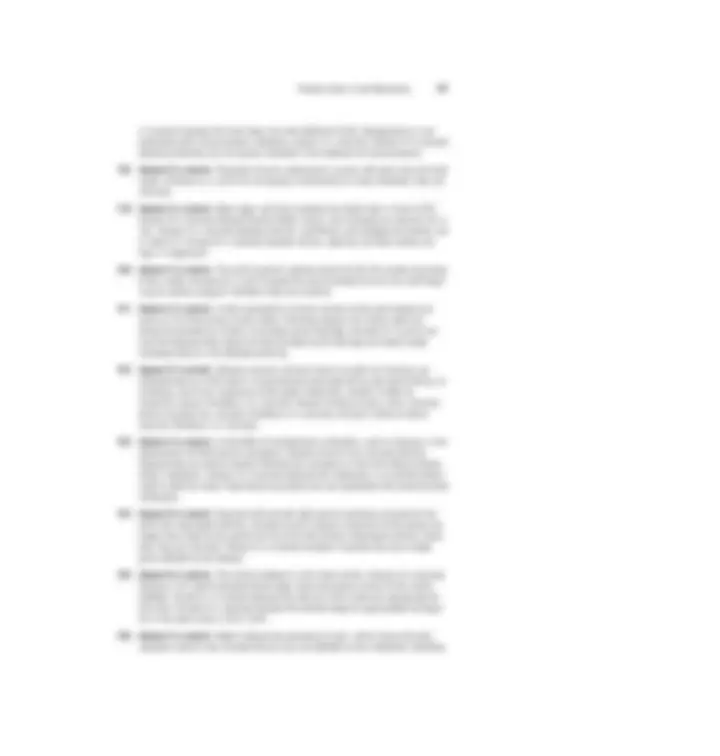
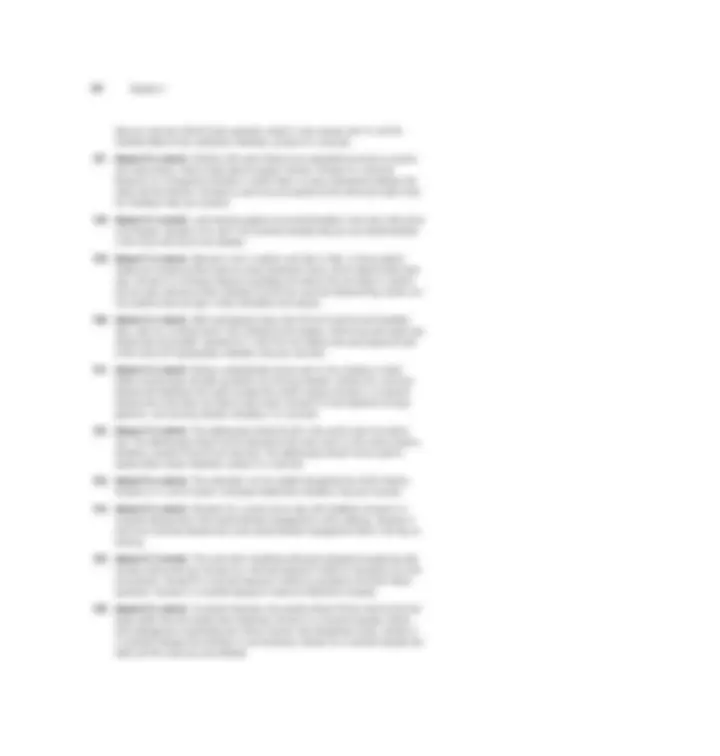
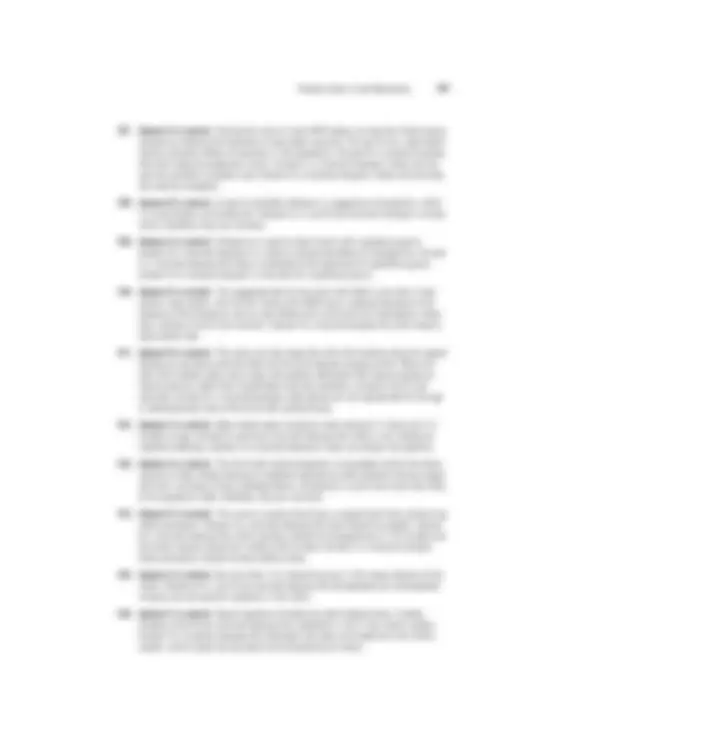
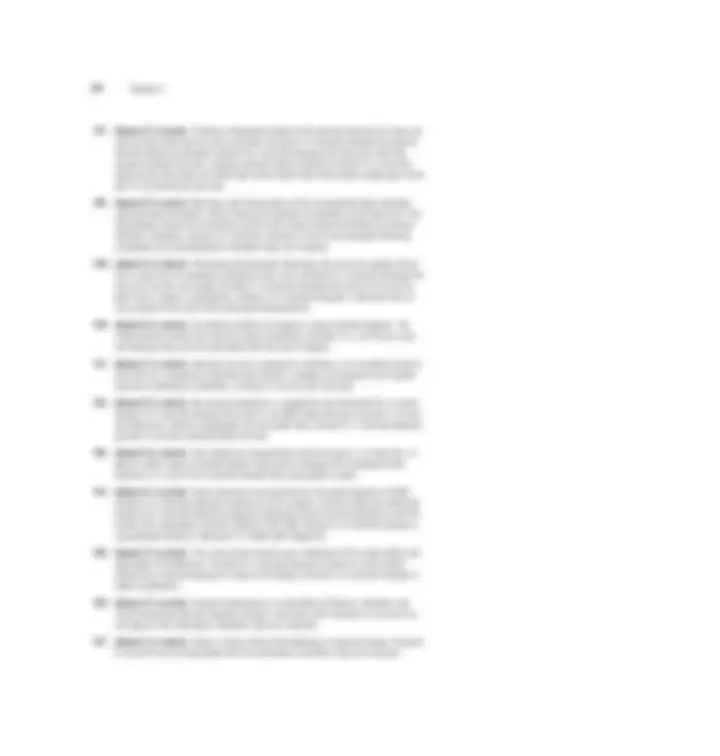
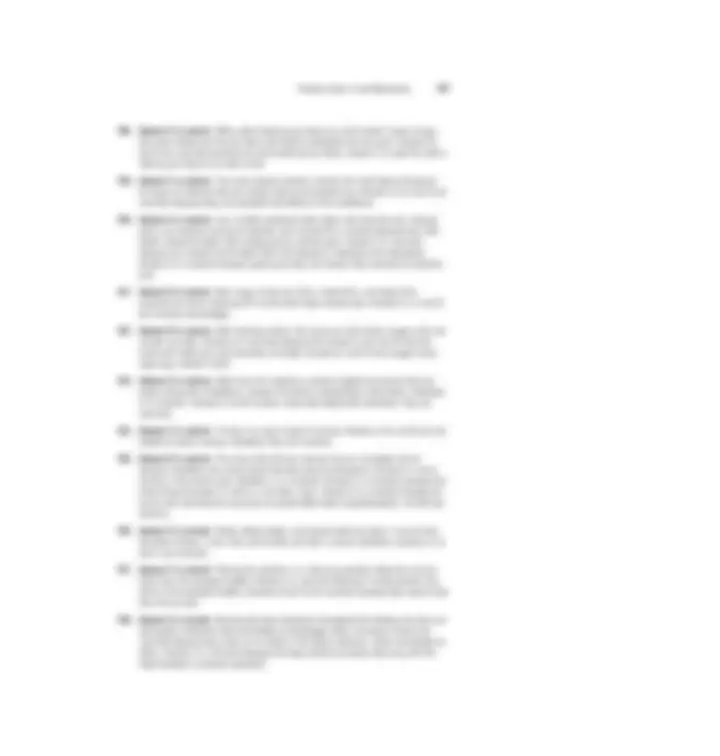
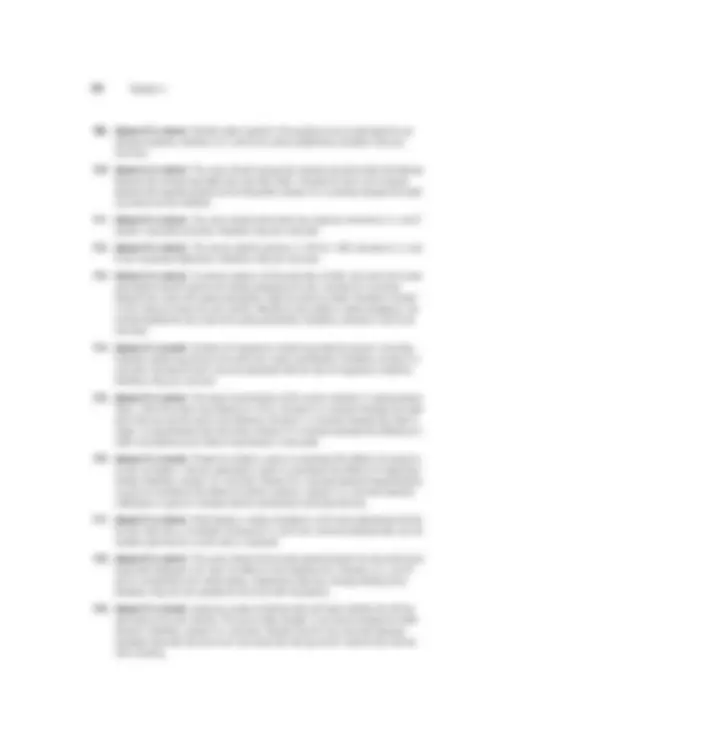
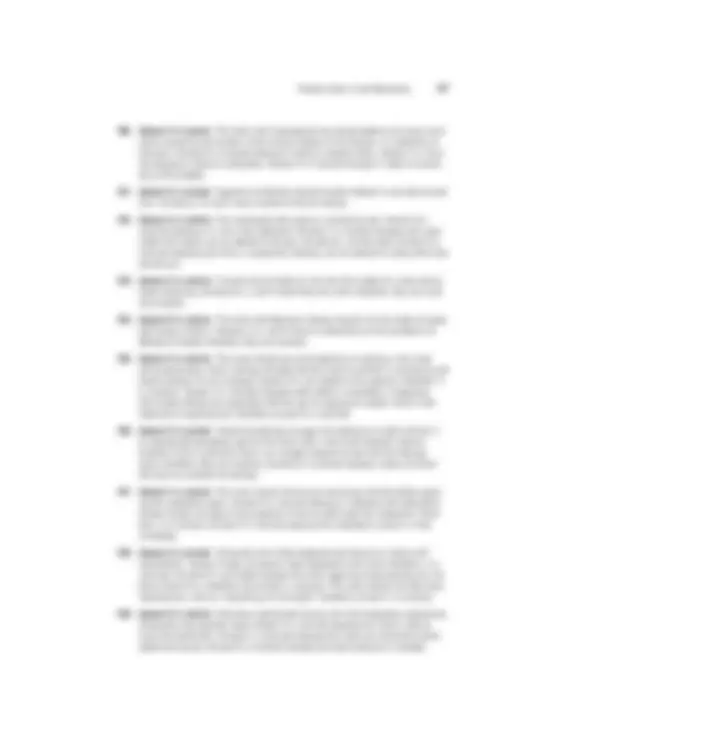
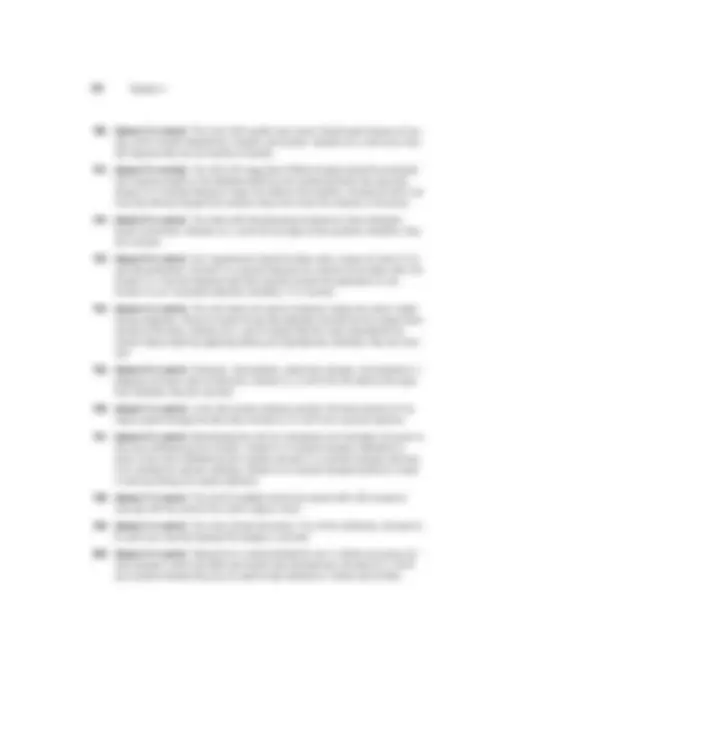


Study with the several resources on Docsity

Earn points by helping other students or get them with a premium plan


Prepare for your exams
Study with the several resources on Docsity

Earn points to download
Earn points by helping other students or get them with a premium plan
Community
Ask the community for help and clear up your study doubts
Discover the best universities in your country according to Docsity users
Free resources
Download our free guides on studying techniques, anxiety management strategies, and thesis advice from Docsity tutors
A series of instructions and quick answers for post-operative care, including maintaining head position, using caution with certain medications, and assessing clients. Detailed answers and quick checks are also included.
What you will learn
Typology: Study notes
1 / 64

This page cannot be seen from the preview
Don't miss anything!

























































1. A client hospitalized with severe depression and suicidal ideation refuses to talk with the nurse. The nurse recognizes that the suici- dal client has difficulty:
2. A client receiving hydrochlorothiazide is instructed to increase her dietary intake of potassium. The best snack for the client requiring increased potassium is:
3. The nurse is caring for a client following removal of the thyroid. Immediately post-op, the nurse should:
head and neck supported by pillows
promote drainage of oral secretions
placed on either side of the head and neck
every 2 hours, with the neck in a flexed position
Quick Answers: 187 Detailed Answer: 190
Quick Answers: 187 Detailed Answer: 190
Quick Answers: 187 Detailed Answer: 190
Quick Check
(^146) Chapter 3
4. A client hospitalized with chronic dyspepsia is diagnosed with gastric cancer. Which of the following is associated with an increased incidence of gastric cancer?
5. A client is sent to the psychiatric unit for forensic evaluation after he is accused of arson. His tentative diagnosis is antisocial per- sonality disorder. In reviewing the client’s record, the nurse could expect to find:
6. The licensed vocational nurse may not assume the primary care for a client:
7. The physician has ordered dressings with Sulfamylon cream for a client with full-thickness burns of the hands and arms. Before dressing changes, the nurse should give priority to:
8. The nurse is teaching a group of parents about gross motor devel- opment of the toddler. Which behavior is an example of the nor- mal gross motor skill of a toddler?
Quick Answers: 187 Detailed Answer: 190
✓
Quick Check
Quick Answers: 187 Detailed Answer: 190
Quick Answers: 187 Detailed Answer: 190
Quick Answers: 187 Detailed Answer: 190
Quick Answers: 187 Detailed Answer: 190
(^148) Chapter 3
14. An elderly client who experiences nighttime confusion wanders from his room into the room of another client. The nurse can best help decrease the client’s confusion by:
falls asleep
shifts
15. Which of the following is a common complaint of the client with end-stage renal failure?
16. Which of the following medication orders needs further clarification?
17. The best diet for the client with Meniere’s syndrome is one that is:
18. Which of the following findings is associated with right-sided heart failure?
Quick Answers: 187 Detailed Answer: 191
✓
Quick Check
Quick Answers: 187 Detailed Answer: 191
Quick Answers: 187 Detailed Answer: 191
Quick Answers: 187 Detailed Answer: 191
Quick Answers: 187 Detailed Answer: 191
Practice Exam 3 and Rationales^149
19. An 8-year-old admitted with an upper-respiratory infection has an order for O 2 saturation via pulse oximeter. To ensure an accurate reading, the nurse should:
a reading
20. An infant with Tetralogy of Fallot is discharged with a prescription for lanoxin elixir. The nurse should instruct the mother to:
per in the bottle
water
21. The client scheduled for electroconvulsive therapy tells the nurse, “I’m so afraid. What will happen to me during the treatment?” Which of the following statements is most therapeutic for the nurse to make?
treatment.”
seizure.”
after the treatment.”
22. Which of the following skin lesions is associated with Lyme’s dis- ease?
Quick Answers: 187 Detailed Answer: 191
✓
Quick Check
Quick Answers: 187 Detailed Answer: 191
Quick Answers: 187 Detailed Answer: 191
Quick Answers: 187 Detailed Answer: 191
Practice Exam 3 and Rationales^151
28. An 8-year-old is admitted with drooling, muffled phonation, and a temperature of 102°F. The nurse should immediately notify the doctor because the child’s symptoms are suggestive of:
29. Phototherapy is ordered for a newborn with physiologic jaundice. The nurse caring for the infant should:
mula
infant
30. A teen hospitalized with anorexia nervosa is now permitted to leave her room and eat in the dining room. Which of the following nursing interventions should be included in the client’s plan of care?
after she eats
plate
31. According to Erickson’s stage of growth and development, the developmental task associated with middle childhood is:
32. The nurse should observe for side effects associated with the use of bronchodilators. A common side effect of bronchodilators is:
Quick Answers: 187 Detailed Answer: 192
✓
Quick Check
Quick Answers: 187 Detailed Answer: 192
Quick Answers: 187 Detailed Answer: 192
Quick Answers: 187 Detailed Answer: 192
Quick Answers: 187 Detailed Answer: 192
(^152) Chapter 3
33. The 5-minute Apgar of a baby delivered by C-section is recorded as 9. The most likely reason for this score is:
34. A 5-month-old infant is admitted to the ER with a temperature of 103.6°F and irritability. The mother states that the child has been listless for the past several hours and that he had a seizure on the way to the hospital. A lumbar puncture confirms a diagnosis of bacterial meningitis. The nurse should assess the infant for:
35. A client with a bowel resection and anastamosis returns to his room with an NG tube attached to intermittent suction. Which of the following observations indicates that the nasogastric suc- tion is working properly?
36. The nurse is teaching the client with insulin-dependent diabetes the signs of hypoglycemia. Which of the following signs is associ- ated with hypoglycemia?
37. Which of the following symptoms is associated with exacerbation of multiple sclerosis?
Quick Answers: 187 Detailed Answer: 193
✓
Quick Check
Quick Answers: 187 Detailed Answer: 193
Quick Answers: 187 Detailed Answer: 193
Quick Answers: 187 Detailed Answer: 193
Quick Answers: 187 Detailed Answer: 193
(^154) Chapter 3
43. The physician has prescribed Cytoxan (cyclophosphamide) for a client with nephotic syndrome. The nurse should:
44. The nurse is caring for a client with detoxification from alcohol. Which medication is used in the treatment of alcohol withdrawal?
45. A client with insulin-dependent diabetes takes 20 units of NPH insulin at 7 a.m. The nurse should observe the client for signs of hypoglycemia at:
46. The licensed practical nurse is assisting the charge nurse in plan- ning care for a client with a detached retina. Which of the follow- ing nursing diagnoses should receive priority?
47. The primary purpose for using a CPM machine for the client with a total knee repair is to help:
Quick Answers: 187 Detailed Answer: 193
✓
Quick Check
Quick Answers: 187 Detailed Answer: 194
Quick Answers: 187 Detailed Answer: 194
Quick Answers: 187 Detailed Answer: 194
Quick Answers: 187 Detailed Answer: 194
Practice Exam 3 and Rationales^155
48. Which of the following statements reflects Kohlberg’s theory of the moral development of the preschool-age child?
49. A toddler with otitis media has just completed antibiotic therapy. A recheck appointment should be made to:
hearing
50. A factory worker is brought to the nurse’s office after a metal frag- ment enters his right eye. The nurse should:
applicator
51. The nurse is caring for a client with systemic lupus erythematosis (SLE). The major complication associated with systemic lupus erythematosis is:
52. Which diet is associated with an increased risk of colorectal cancer?
Quick Answers: 187 Detailed Answer: 194
✓
Quick Check
Quick Answers: 187 Detailed Answer: 194
Quick Answers: 187 Detailed Answer: 194
Quick Answers: 187 Detailed Answer: 194
Quick Answers: 187 Detailed Answer: 194
Practice Exam 3 and Rationales^157
58. A client with hypothyroidism frequently complains of feeling cold. The nurse should tell the client that she will be more comfortable if she:
59. A client has been hospitalized with a diagnosis of laryngeal cancer. Which factor is most significant in the development of laryngeal cancer?
60. The nurse is completing an assessment history of a client with pernicious anemia. Which complaint differentiates pernicious ane- mia from other types of anemia?
61. The chart of a client with schizophrenia states that the client has echolalia. The nurse can expect the client to:
62. Which early morning activity helps to reduce the symptoms asso- ciated with rheumatoid arthritis?
Quick Answers: 187 Detailed Answer: 195
✓
Quick Check
Quick Answers: 187 Detailed Answer: 195
Quick Answers: 187 Detailed Answer: 195
Quick Answers: 187 Detailed Answer: 195
Quick Answers: 187 Detailed Answer: 195
(^158) Chapter 3
63. A newborn weighed 7 pounds at birth. At 6 months of age, the infant could be expected to weigh:
64. A client with nontropical sprue has an exacerbation of symptoms. Which meal selection is responsible for the recurrence of the client’s symptoms?
65. A client with congestive heart failure has been receiving Digoxin (lanoxin). Which finding indicates that the medication is having a desired effect?
66. Which play activity is best suited to the gross motor skills of the toddler?
67. The physician has ordered Basalgel (aluminum carbonate gel) for a client with recurrent indigestion. The nurse should teach the client common side effects of the medication, which include:
Quick Answers: 187 Detailed Answer: 195
✓
Quick Check
Quick Answers: 187 Detailed Answer: 196
Quick Answers: 187 Detailed Answer: 196
Quick Answers: 187 Detailed Answer: 196
Quick Answers: 187 Detailed Answer: 196
(^160) Chapter 3
73. A client is admitted with a diagnosis of hypothyroidism. An initial assessment of the client would reveal:
ure
respiratory rate
increased respirations
74. Which statement describes the contagious stage of varicella?
rash until the appearance of vesicles.
crusting stages of the lesions.
until the rash disappears.
rash until all the lesions are crusted.
75. A client admitted to the psychiatric unit claims to be the Son of God and insists that he will not be kept away from his followers. The most likely explanation for the client’s delusion is:
76. The nurse is caring for an 8-year-old following a routine tonsillectomy. Which finding should be reported immediately?
Quick Answers: 187 Detailed Answer: 196
✓
Quick Check
Quick Answers: 187 Detailed Answer: 197
Quick Answers: 187 Detailed Answer: 197
Quick Answers: 187 Detailed Answer: 197
Practice Exam 3 and Rationales^161
77. The nurse is admitting a client with a suspected duodenal ulcer. The client will most likely report that his abdominal discomfort lessens when he:
78. Which of the following meal selections is appropriate for the client with celiac disease?
79. A client with hyperthyroidism is taking lithium carbonate to inhibit thyroid hormone release. Which complaint by the client should alert the nurse to a problem with the client’s medication?
urination.
past year.
80. A 2-month-old infant has just received her first Tetramune injec- tion. The nurse should tell the mother that the immunization:
of age
to pertussis
dpt and Hib
varicella
Quick Answers: 187 Detailed Answer: 197
✓
Quick Check
Quick Answers: 187 Detailed Answer: 197
Quick Answers: 187 Detailed Answer: 197
Quick Answers: 187 Detailed Answer: 197
Practice Exam 3 and Rationales^163
86. A client with a deep decubitus ulcer is receiving therapy in the hyperbaric oxygen chamber. Before therapy, the nurse should:
87. A client with a laryngectomy returns from surgery with a nasogas- tric tube in place. The primary reason for placement of the naso- gastric tube is to:
88. The chart indicates that a client has expressive aphasia following a stroke. The nurse understands that the client will have difficulty with:
89. A camp nurse is applying sunscreen to a group of children enrolled in swim classes. Chemical sunscreens are most effective when applied:
90. A post-operative client has an order for Demerol (meperidine) 75mg and Phenergan (promethazine) 25mg IM every 3–4 hours as needed for pain. The combination of the two medications pro- duces a/an:
Quick Answers: 187 Detailed Answer: 198
Quick Answers: 187 Detailed Answer: 198
Quick Answers: 188 Detailed Answer: 198
✓
Quick Check
Quick Answers: 188 Detailed Answer: 198
Quick Answers: 188 Detailed Answer: 198
(^164) Chapter 3
91. Before administering a client’s morning dose of Lanoxin (digoxin), the nurse checks the apical pulse rate and finds a rate of 54. The appropriate nursing intervention is to:
92. What information should the nurse give a new mother regarding the introduction of solid foods for her infant?
reflex disappears, at 8–10 months of age.
4- to 7-day intervals.
make feeding easier.
93. A client with schizophrenia is started on Zyprexa (olanzapine). Three weeks later, the client develops severe muscle rigidity and elevated temperature. The nurse should give priority to:
94. A client with human immunodeficiency syndrome has gastroin- testinal symptoms, including diarrhea. The nurse should teach the client to avoid:
95. A 4-year-old is admitted with acute leukemia. It will be most important to monitor the child for:
Quick Answers: 188 Detailed Answer: 198
✓
Quick Check
Quick Answers: 188 Detailed Answer: 198
Quick Answers: 188 Detailed Answer: 198
Quick Answers: 188 Detailed Answer: 198
Quick Answers: 188 Detailed Answer: 199